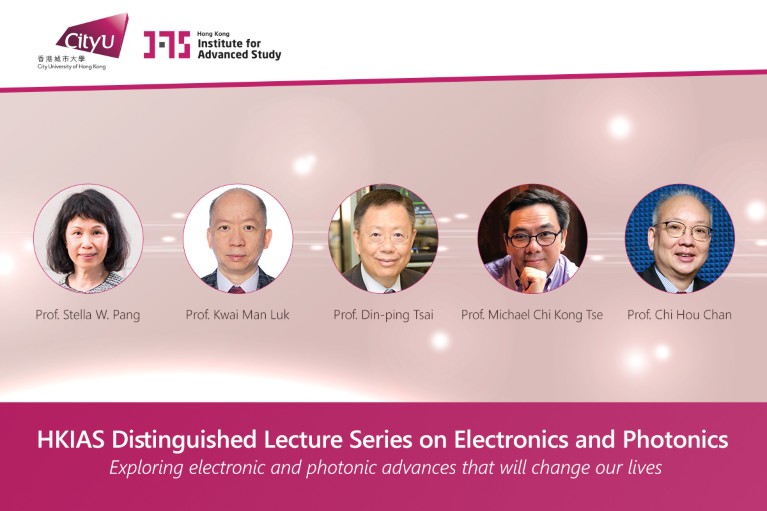
Credit: HKIAS
Electronics and photonics underpin countless aspects of life. In Hong Kong the electronics industry accounted for more than 70% of exports in 2020. And with the emergence of the Guangdong–Hong Kong–Macao Greater Bay Area as an innovation and technology hub, R&D in electronics and photonics here is a driving force.
To explore challenges and opportunities for these technologies, researchers from the Department of Electrical Engineering (EE) at the City University of Hong Kong (CityU) presented a series of webcasts at the Hong Kong Institute for Advanced Study (HKIAS) in March and April. They discussed advances in nanotechnology, wireless communication, photonics, electrical power grids and terahertz technology — and in doing so, connected a diverse group of interdisciplinary scientists and industry professionals.
Nanotechnology and nanodevices
Integrated circuits (ICs), the fundamental building blocks of many devices, are shrinking. “Smaller means higher performance, less energy consumption and lower cost. Any ICs these days involve nanotechnology,” said Stella W. Pang, head of the EE Department.
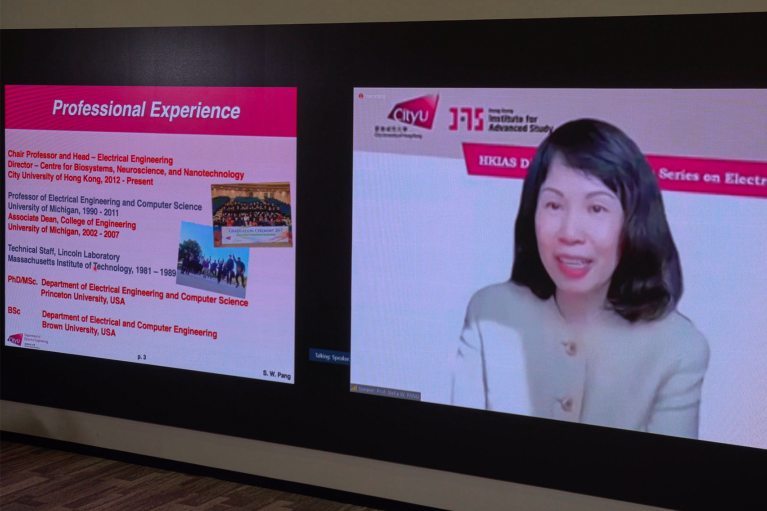
Stella Pang explained the application of nanodevices in “Nanotechnology for High-Performance Devices and Sensors” on 1 March 2022.Credit: HKIAS
Pang described how nanotechnologies such as nanoimprint, dry etching and conformal deposition, combined with new materials and designs, have enabled the creation of devices and microsystems with multiple functions. These can be used in biosensing and imaging, terahertz antennas and metadevices, which utilize the properties of novel nanodevices.
Pang and her colleagues have generated high-performance microfluidic biosensors to help understand biophysical processes. By using nanostructures on 3D biomimetic platforms, these highly sensitive biosensors can detect live cancer cells at very low concentrations, and even separate them from healthy cells based on their biophysical properties. The sensors can also detect micrometre-scale filopodia — protrusions from the cell membrane — allowing the control of cell migration.
Optical metadevices
Metamaterials are artificially structured materials with properties not found in natural materials. When and how metadevice products based on these will be commercially available was discussed by the chair professor of the EE Department, Din-ping Tsai, in his lecture.
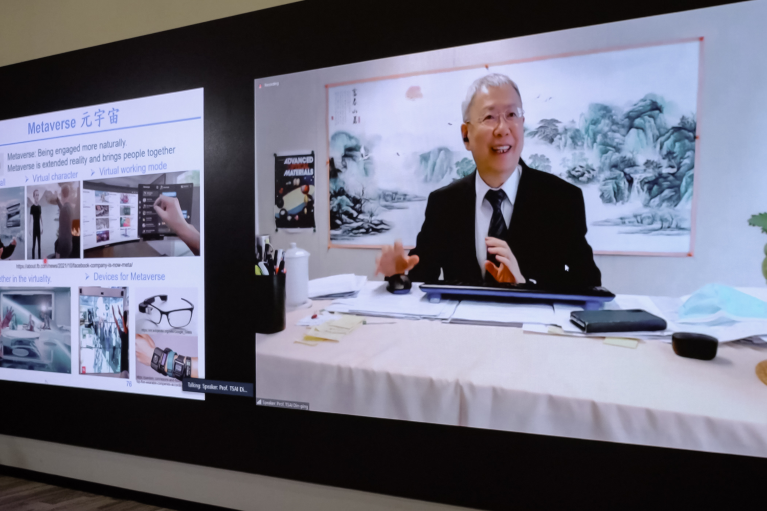
Din-ping Tsai discussed the application of metadevices in “Meta-Devices: From Sensing and Imaging to Quantum Optical Chip” on 30 March 2022.Credit: HKIAS
One example of an optical metadevice is an achromatic metalens array — a lightweight, compact, mass-producible alternative to the bulky and complex lens-set used in broadband and full-colour imaging and light-field sensing systems. Experimental results show great potential for their use in robotic vision, autonomous vehicles, nanorobots, mini-drones, and virtual reality systems. Tsai explained their current works could shape the future of imaging, sensing and quantum computing. His team’s studies have also supported the design and fabrication of a 10 x 10 array of metalenses for a high-dimensional quantum entangled optical source chip.
Wireless communication
Kwai Man Luk, another chair professor of the EE Department, shared his research on the potential of antennas, which he says are crucial to wireless communication and sensing, supporting applications from navigation and radio telescopes, to energy harvesting.
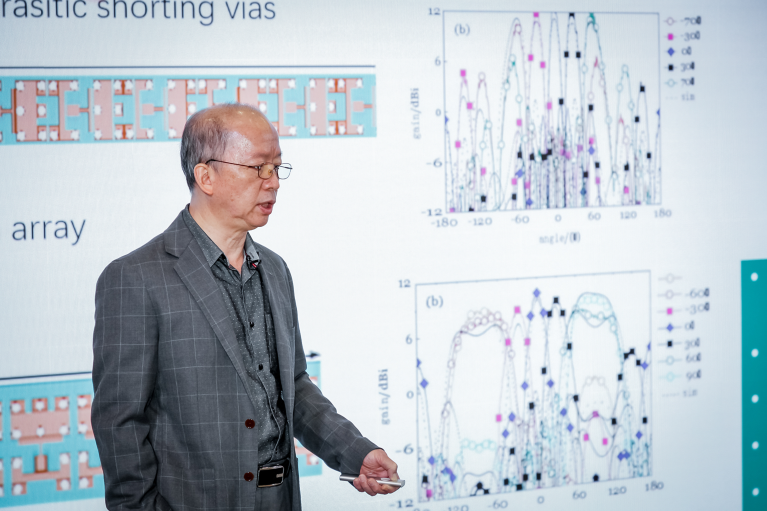
Kwai Man Luk shared his research on antennas and their potential applications in “Antenna Scientists – Magicians in the Era of Wireless Connectivity” on 17 March 2022.Credit: HKIAS
He walked the audience through breakthroughs in the development of antennas over the past three decades, elaborating on his research on wideband microstrip antennas, and dielectric resonator antennas.
Luk and other CityU researchers are exploring potential applications of magneto-electric (ME) dipole antennas, invented by his team, which have both a magnetic dipole and an electric dipole, which allows for more efficient wideband transmission.
“Our work helps meet the needs of modern wireless applications,” Luk noted. For example, his ME dipole technology could pave the way for the use of antennas in medical imaging for the diagnosis of conditions such as stroke, more quickly and at lower cost.
Terahertz antennas for 6G
One of Luk’s colleagues is Chi Hou Chan, chair professor of the EE Department and director of the State Key Laboratory of Terahertz and Millimeter Waves at CityU. Chan has been investigating terahertz antennas and sources for future 6G applications.
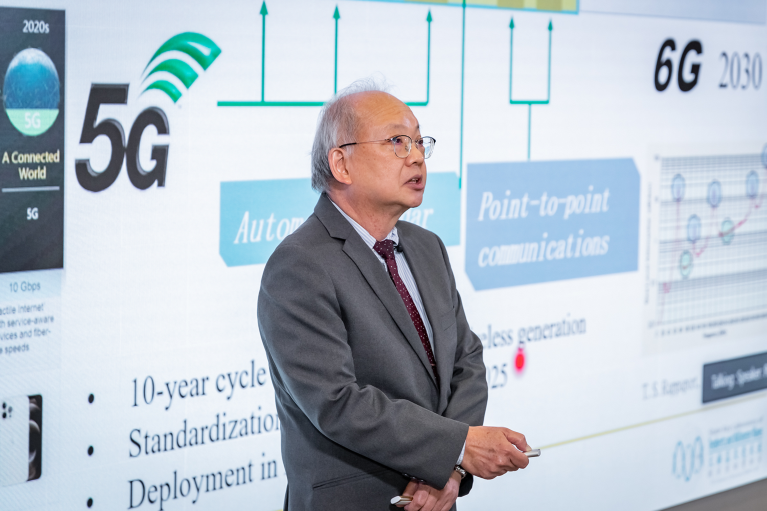
Chi Hou Chan shared his insights of terahertz antennas and recent inventions in “Are We Ready for 6G” on 22 April 2022.Credit: HKIAS
6G is expected to have significant advantages over 5G, including extremely high data capacity, reliability and coverage. It will support many new applications such as chip-to-chip and machine-to-machine wireless communication, especially for big data centres.
High frequencies ranging from 100 GHz to 3 THz are central in 6G networks, says Chan, meaning that THz antennas and integrated circuits are the key 6G enabling techniques. Chan and other CityU reseachers have developed a series of THz sources and THz antennas, which are now ready for use in THz imaging.
“We hope to conduct innovative THz research, to prepare ourselves for 6G,” he says.
Increasing need to convert electricity
Electricity grids are among “the most important and most indispensable infrastructures,” said Michael Chi Kong Tse, chair professor of the EE Department. Today’s electricity infrastructure is undergoing a rapid transformation, featured by the increasing deployment of ‘power electronics’ — which involves the processing of high voltages and currents into a variety of forms depending on needs.
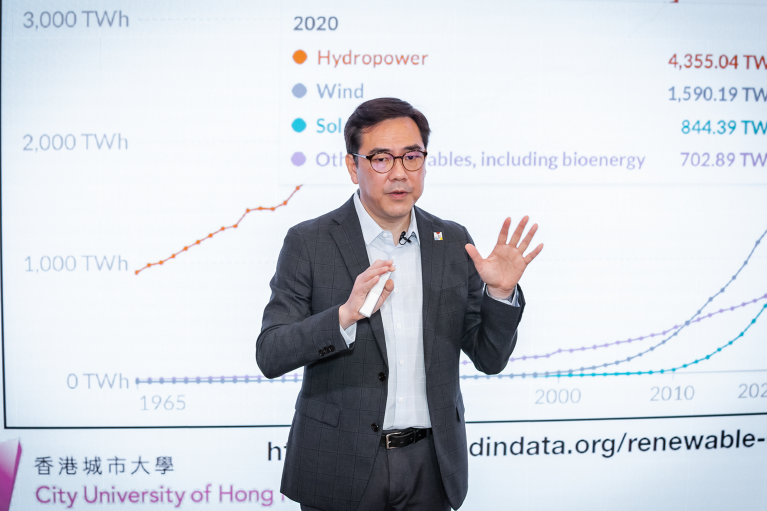
Michael Chi Kong Tse gave the lecture “Challenges of Modern Power Grid in the Midst of Deepening Power Electronics Penetration and Increasing Renewable Energy Use” on 12 April 2022.Credit: HKIAS
As society increasingly moves towards carbon neutrality, the energy industry is seeking more renewable sources such as solar and wind power. Electric vehicle chargers are rapidly popping up in cities to meet rising needs and electricity generated from renewables is being pumped into the power grid through electronics devices which employ semiconductor switches to regulate and control the supply of energy.
However, there are concerns about the stability and robustness of electricity grids, according to Tse. Conventional synchronous machines — electromechanical transducers that convert mechanical energy into electrical energy — continue to dominate power generation systems. Power electronics devices, however, have different mechanisms and dynamics, and their integration and coexistence with synchronous machines poses challenges to the design and operation of the electricity grid.
Tse argues for two approaches to address these issues: a bottom-up approach, focusing on the performance of electric circuits at specific locations in a connected grid; and a top-down approach, focusing on the design and control of connected subsystems. By combining these fixes, we can create better models that incorporate increasing numbers of power electronic devices resulting in safer, smarter, and more robust power generation and delivery systems, he says.
Promoting academic collaboration
Supported in part by the Kwang Hua Educational Foundation, the HKIAS Distinguished Lecture Series on Electronics and Photonics highlighted the multidisciplinary and highly collaborative research efforts in this field to advance technology. The lectures attracted more than 2,000 academic and industry participants from around the world.
Next, HKIAS will hold the first Heterostructured (HS) Materials Conference from July 12 to 15, 2022, gathering international researchers to discuss trends in materials science.
For more information, please visit: www.ias.cityu.edu.hk


